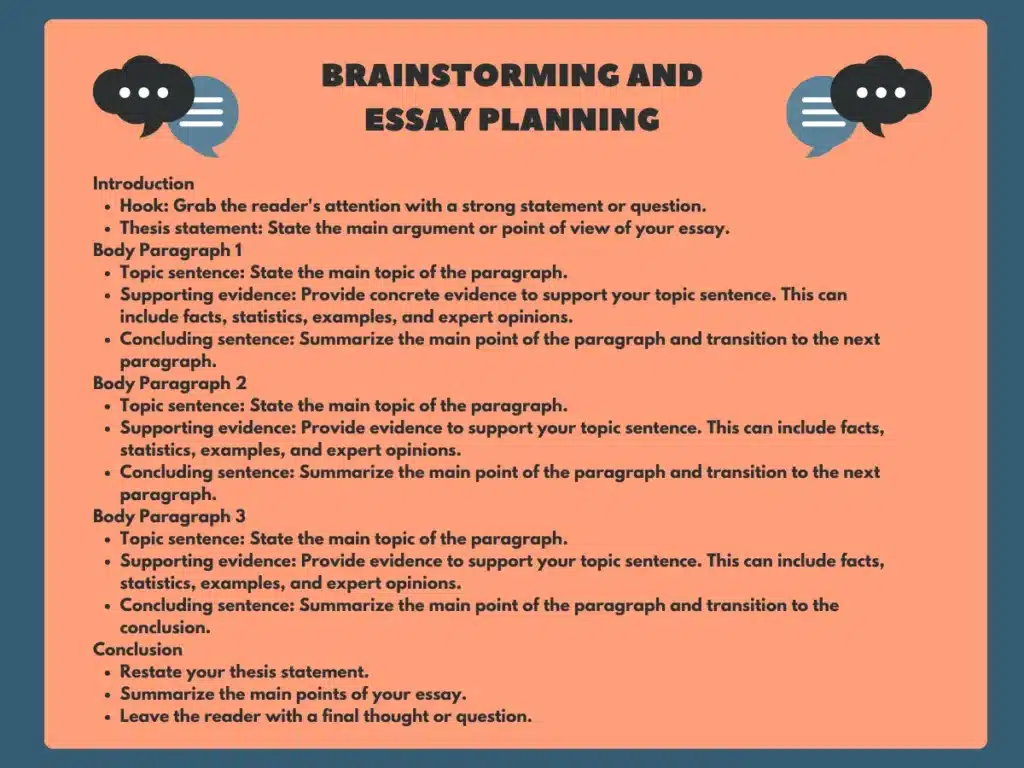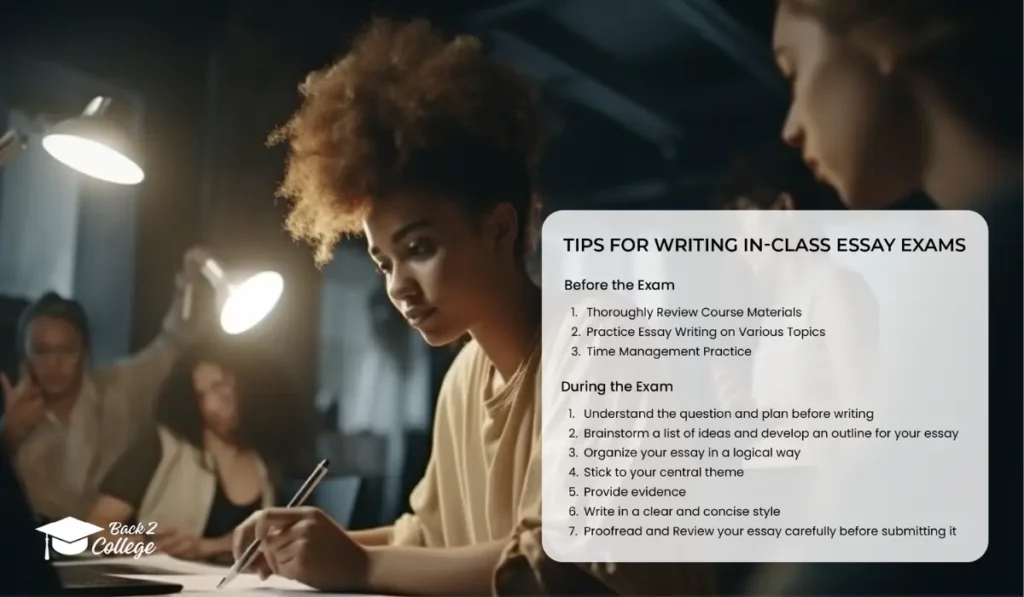In-class essay exams are significant in the college grading methodology. These exams test your knowledge, understanding of study material, and ability to explain your knowledge in a specific duration. Doing well in these exams will improve your grades and overall academics. Students learn how to manage time and be precise in these time-bound tasks. These learnings will play a role in your future projects.
In-class essay exams are time-bound tasks, and you must finish them quickly and with quality to score good grades.
This article will present practical tips for writing in-class essay exams quickly and accurately. You will find actionable tips on how to prepare before the exam, practice answering, and manage your time to express the main point with specific evidence. Keep reading.
Writing a college essay involves several key steps. Start by understanding the essay prompt and brainstorming ideas. Create an outline to organize your thoughts and structure the essay logically. Craft a compelling introduction that grabs the reader’s attention, followed by body paragraphs that support your main points with evidence and examples. Ensure each paragraph flows coherently and relates back to the thesis statement. Conclude by summarizing your main arguments and reinforcing the essay’s significance. Finally, revise and edit for clarity, coherence, and grammar before submitting.
Before the Exam
Exam preparation is essential for success. By taking the time to prepare before the exam, you can increase your chances of doing well.
Here are three key tips for preparation before an in-class essay test:
1. Thoroughly Review Course Materials
Before the exam, make sure to carefully go through your course materials. This step is essential to become well-acquainted with the critical concepts and ideas that the exam might cover. Take the time to revisit your class notes, textbooks, and any relevant readings. This foundational knowledge will serve as the backbone for your essay responses.
2. Practice Essay Writing on Various Topics

To enhance your essay-writing skills, engage in practicing essays on a range of topics. This practice not only hones your ability to express ideas clearly but also helps you understand how to structure an essay effectively. Consider addressing diverse essay prompts and experimenting with different writing styles. This practice will make you more versatile in approaching essay questions during the exam.
3. Time Management Practice
Efficient time management is of utmost importance during an in-class essay exam. To excel in this area, it’s crucial to time yourself while practicing essay writing.
Establish realistic time limits for each phase of the essay-writing process: brainstorming, outlining, drafting, and proofreading. By mastering the art of allocating your time effectively, you ensure that you can successfully complete your essays within the confines of the exam’s time constraints.
Maintain a timer during your practice sessions to instill a sense of time-bound tasks. This will familiarize you with the entire process, making in-class essay writing second nature. Additionally, through consistent practice, you’ll stay composed and collected during the actual exam.
By following these three essential preparation tips, you’ll be well-prepared to tackle in-class essay exams with confidence and skill.
During the Exam
Once you have arrived for the exam, it is important to stay calm and focused. Take a few deep breaths and remind yourself that you are prepared.
Here are some tips for what to do during the exam:
1. Understand the question and plan before writing
Read the question carefully and understand the main topic and what it is asking you. Identify key words like “discuss,” “explain,” “compare,” or “prove” to know the intent of the question. Plan your answer once you understand the question. Create an outline for the answer and choose the main points that you will present and discuss. Arrange the points to ensure the logical flow of the answer so that your teacher can easily follow it.
2. Brainstorm a list of ideas and develop an outline for your essay.
To excel in in-class essay exams, it’s vital to master the art of brainstorming and crafting a structured outline. Begin by reading the prompt carefully to understand what’s required. Then, brainstorm a list of ideas related to the prompt. Group them to find common themes, and select the most relevant ones that align with the prompt.
Your outline acts as a blueprint, showing how your ideas will be organized and support your thesis. Remember, keep the essay prompt’s key words in mind for relevance. Familiarize yourself with various essay types, and practice with different prompts to refine your skills.
To brainstorm a list of ideas and develop an outline for your in-class essay exams, follow these steps:
- Analyze the prompt carefully, identifying key concepts and important ideas.
- Pick a topic you understand and find interesting for a smooth answering process.
- Brainstorm ideas related to the prompt without worrying about completeness.
- Group ideas with common themes or connections.
- Select the most relevant ideas, guided by the essay prompt.
- Use prompt keywords for focus and relevance.
- Be aware of different essay types for effective brainstorming and outlining.
- Practice with various prompts to refine your skills and gain comfort with the process.
Once you have a list of ideas and have organized them into groups, you can begin to develop an outline for your essay. Your outline should show how your ideas will be organized and how they will support your thesis statement.
Here is a simple outline template that you can use:

This is just a basic outline template, of course. You may need to adjust it to fit the specific essay question that you are being asked. But by following these tips, you can brainstorm and outline a clear, concise, and well-organized in-class essay.
3. Organize your essay in a logical way
In crafting a well-structured essay, several strategies can be employed for a logical flow. Here are some valuable tips:
- Choose an Organizational Pattern: Selecting an organizational pattern is crucial. Common options include:
- Chronological Order: This arranges your essay in the order of events. Use words like “first,” “second,” “next,” “then,” and “finally” to maintain the chronological flow.
- Spatial Order: Structure your essay based on location, utilizing terms like “above,” “below,” “beyond,” “behind,” “beside,” “between,” “in front of,” and “on top of.”
- Cause and Effect Order: Organize your essay by explaining causes or effects. Employ phrases like “because,” “as a result,” “therefore,” “consequently,” and “thus.”
- Problem-Solution Order: Identify a problem and propose a solution. Use words such as “first,” “second,” “next,” “then,” and “finally” for this structure.
- Compare and Contrast Order: Analyze and contrast two or more things. Include terms like “similarly,” “differently,” “on the other hand,” “in contrast,” and “however.”
Once you’ve made your choice, stick with it throughout your essay. Consistency in organization ensures a smooth, reader-friendly flow.
- Craft a Clear Thesis Statement: Your thesis statement is the central argument of your essay. It should be concise, clear, and open to debate. Place it in the introduction and support it with evidence in the body paragraph of your essay.
- Utilize Topic Sentences: Every paragraph should begin with a topic sentence, which encapsulates the main idea. These sentences should be reinforced with evidence within the paragraphs.
- Employ Concluding Sentences: A concluding sentence should sum up the primary idea of a paragraph and smoothly transition to the next one.
4. Stick to your central theme
Stick to your main points of the answer. Do not deviate from them and start giving different and irrelevant arguments. Support your ideas and argument with explanations, examples, and any case study. Your in-class essay must be focused on the central theme and present supporting ideas and concepts around that theme. Irrelevant ideas and concepts may dilute the context and logic of the answer and make it harder to follow.
5. Provide evidence
Provide evidence for your claims, thesis, and ideas. Supporting your ideas with evidence gains the trust of the teacher and increases the chances of better grades. Claims without concrete evidence look bluff and irrelevant to the question. Your arguments, thesis, and ideas will look hollow, vague, and unestablished without supporting evidence.
6. Write in a clear and concise style
To craft an essay with precision and brevity, consider these invaluable pointers:
- Trim Excess Phrases: Begin by removing superfluous wording. Employ plain language to express your thoughts. Favor the active voice and reduce wordiness. Avoid commencing sentences with “there is,” “there are,” or “it is,” and cut down on redundant nouns and filler words like “that,” “of,” or “up.”
- Keep It Simple: Opt for straightforward language and shun complexity. Leave out jargon and intricate sentences in favor of clarity and directness.
- Detail Is Key: Provide specific and vivid descriptions. Avoid vague or general language and enhance your writing with rich details.
- Conciseness Is King: Get to the point without delay and minimize excess words and phrases. Clarity often emerges from brevity.
- Activate Your Voice: Employ the active voice, which is concise and direct compared to the passive voice.
- Diversify Sentence Structure: Don’t rely on repetitive sentence structures. Vary your construction to keep your readers engaged.
Here are some specific examples to illustrate these principles:
- Instead of, “The aforementioned individual was in possession of a canine specimen,” say, “The man had a dog.”
- Rather than stating, “The car was fast,” express, “The car could reach speeds exceeding 100 miles per hour.”
- For conciseness, transform, “The reason why I am writing this letter is to inform you that I am resigning from my position” into “I am resigning from my position.”
Additionally, here are some extra tips to elevate your writing:
- Read your work aloud to spot awkward or unclear sentences.
- Consider using a recognized style guide like the Chicago Manual of Style, Associated Press Stylebook, or MLA Style Manual for detailed writing guidelines.
7. Proofread and Review your essay carefully before submitting it
Review your answer for any grammatical errors, irrelevant arguments, ideas, or thesis, and evidence-less claims. Check if the logical flow of the answer is clear. Revise any point or idea that is ambiguous and unclear. Add further clarifications to the ideas and thesis if needed. Remove texts that are irrelevant and vague to provide more clarity.
Proofreading writing assignments involves carefully reviewing your work for errors in spelling, grammar, punctuation, and syntax. It also includes checking for clarity, coherence, and consistency in ideas and arguments. Take time away from the document before proofreading to approach it with fresh eyes. Read the text aloud or use proofreading tools to catch mistakes. Focus on one type of error at a time to ensure thoroughness. Lastly, consider seeking feedback from peers or professors for an additional perspective on your work.
Bonus tips for writing in class essay test questions

- Incorporate the essay prompt’s keywords into your essay to demonstrate your comprehension of the question and direct address.
- Ensure you respond comprehensively to all facets of the exam questions. If it requires multiple actions like analysis, comparison, and contrast, tackle each in your essay.
- Don’t hesitate to assert your perspective. In in-class essay exams, seize the opportunity to showcase your knowledge and critical thinking.
- If you encounter a roadblock, take a deep breath and move forward to the next segment of your essay. You can always return to the challenging part later.
- Be prudent with your time. Avoid excessive focus on any single section of the essay. If time is running short, prioritize completing your conclusion.
A college writing center is a valuable resource that provides students with guidance and support for their writing assignments. It typically offers services such as one-on-one consultations with writing tutors who help students at various stages of the writing process, from brainstorming ideas to polishing final drafts. Writing centers also assist with improving writing skills, refining grammar and style, structuring essays, and citing sources correctly. They are designed to support students in enhancing their writing abilities and producing high-quality academic work.
Final Thoughts
Mastering and practicing the tips for writing in-class essay exams is crucial for every student aiming for better grades and academics. By following tips like understanding the question, outlining the answer, and providing evidence to your claims, a student can improve the quality of the answer.
Practicing writing in-class essays regularly can improve writing speed. Lastly, by reviewing the answer, you can ensure the quality of the answer.













